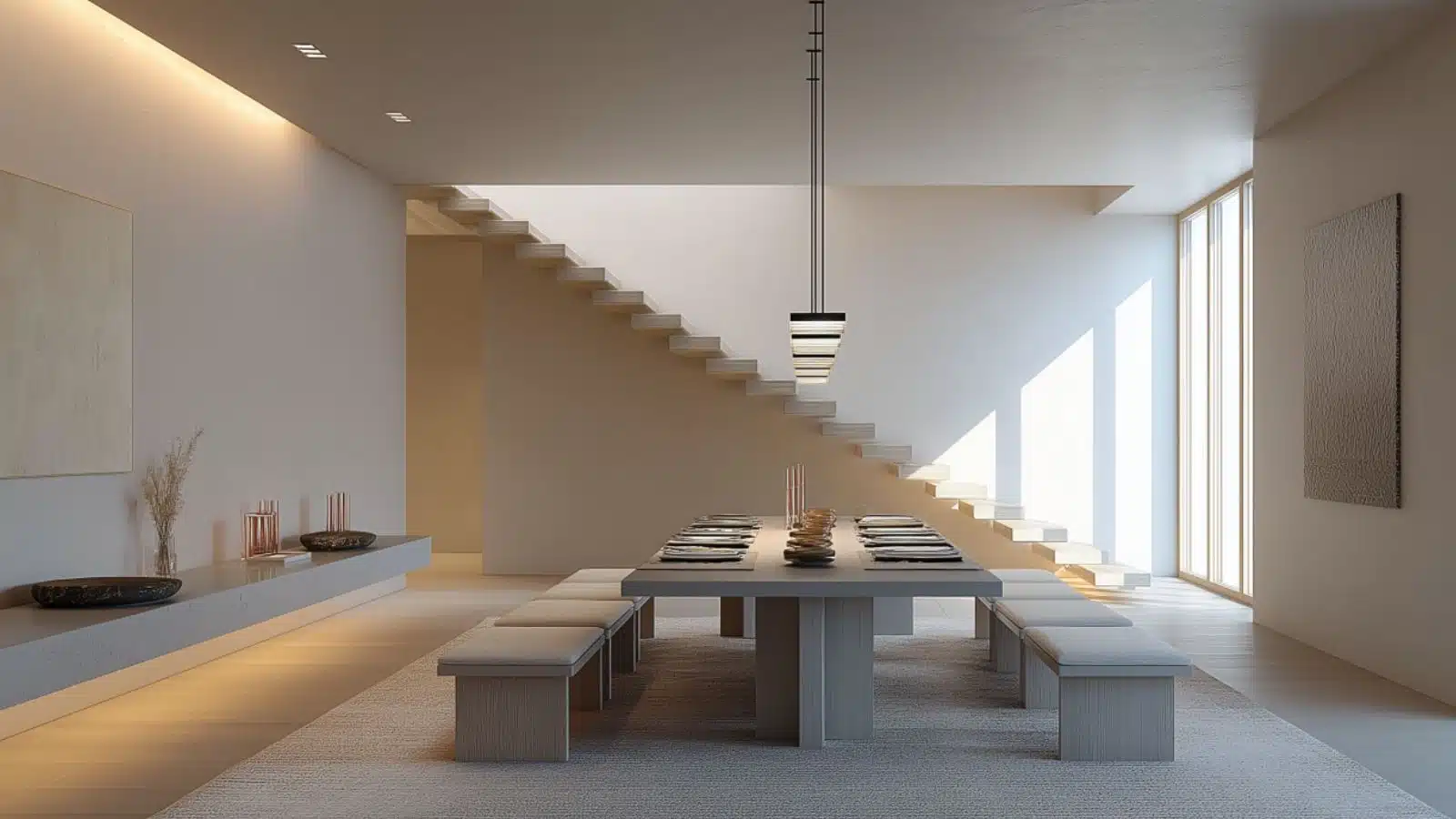Discover Modern Dining Room Ideas with Sleek Minimalist Style for Effortless Elegance
Table of Contents
Do you ever feel overwhelmed by decorative overload in your home? As it turns out, you’re not alone. A recent study by the American Institute of Architects found that 73% of homeowners feel calmer and more focused in rooms with minimal décor. Enter the sleek minimalist dining room—a space where beauty emerges from simplicity, and purpose drives design.
In today’s busy world, a modern dining room with clean lines and uncluttered surfaces offers a moment of visual peace and intentional gathering. Minimalist interiors aren’t cold—they’re curated, functional, and refined. By embracing neutral palettes, high-quality materials, and edited furnishings, you can create a setting that feels both sophisticated and warm.
This guide will walk you through modern dining room ideas that balance sleek, minimalist design with comfort and personality. You’ll learn about clever layout planning, furniture selection, lighting, meaningful accents, natural texture integration, and storage strategies—all with step-by-step visuals and inspiration. Whether you’re refreshing a small dining nook or revamping a spacious eating area, these ideas will help you achieve effortless elegance without sacrificing function.
Maximizing Layout for Open Minimalist Flow
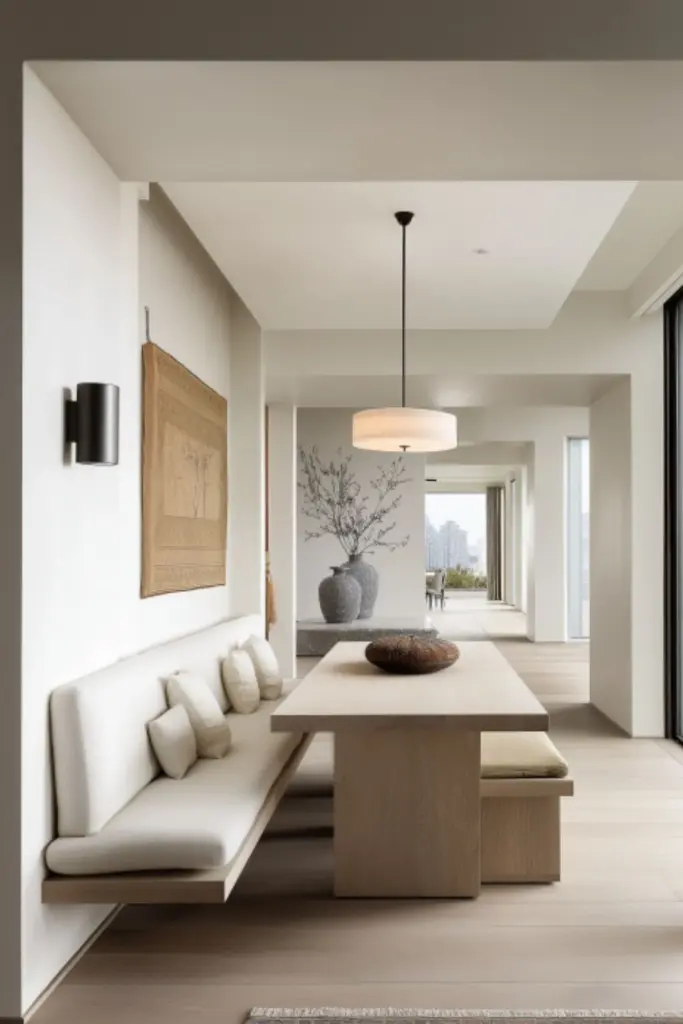
A minimalist dining room truly begins with the layout. Open, airy configurations help maintain a sense of space, even in smaller rooms. If possible, place the table centrally, allowing at least 30–36 inches of circulation space on all sides.
Visual zoning works wonders. Use a rug to define the dining area within an open-plan space. Round tables often feel less imposing in compact areas, and benches tucked under one side can reduce visual bulk while offering flexible seating.
Consider multifunctional layouts—like a sideboard doubling as a bar cart or buffet station. Floating furniture away from the walls can create breathing space and visually lighten the room. Keep pathways to the kitchen or living room clean to maintain seamless flow.
| Layout Strategy | Benefit | Minimalist Tip |
|---|---|---|
| Central table placement | Balanced and open feel | Opt for slim-legged tables |
| Rug zoning | Defines space without walls | Choose low-pile rugs in subtle tones |
| Bench seating | Flexible and visually light | Use one bench and few chairs |
| Floating sideboards | Doubles as storage and styling area | Choose wall-off the floor model |
Selecting Sleek, Modern Furniture
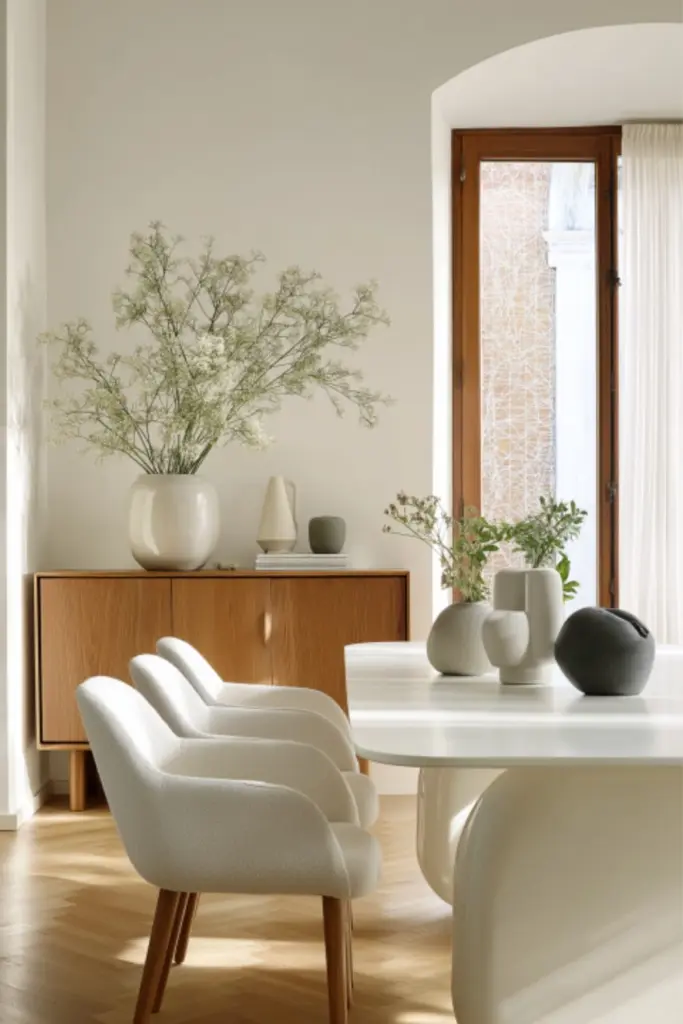
Furniture is the backbone of sleek minimalist style. Choose pieces with clean lines, quality craftsmanship, and versatile proportions. A slender dining table—perhaps in glass, marble, or matte white—provides elegance without heavy visual weight.
Pair with chairs that echo the table’s material and form. Mid-century modern silhouettes in molded plastic or slim wood create harmony and continuity. Benches offer a compact seating option while maintaining a streamlined look.
A sideboard is the ideal anchor—select a low-profile design in a crisp finish or natural wood. Functional and stylish, it’s the perfect stage for limited but meaningful décor.
| Furniture Piece | Modern Minimalist Material | Design Detail |
|---|---|---|
| Dining table | Marble, glass, matte lacquered wood | Pedestal or slim legs |
| Dining chairs | Molded wood, leather, metal | Streamlined pops of texture |
| Bench seating | Upholstered or wood | Simple silhouette, under-table storage |
| Sideboard/console | Lacquered finish or teak | Clean doors, hidden hardware |
Illuminating with Minimalist Lighting and Ambience
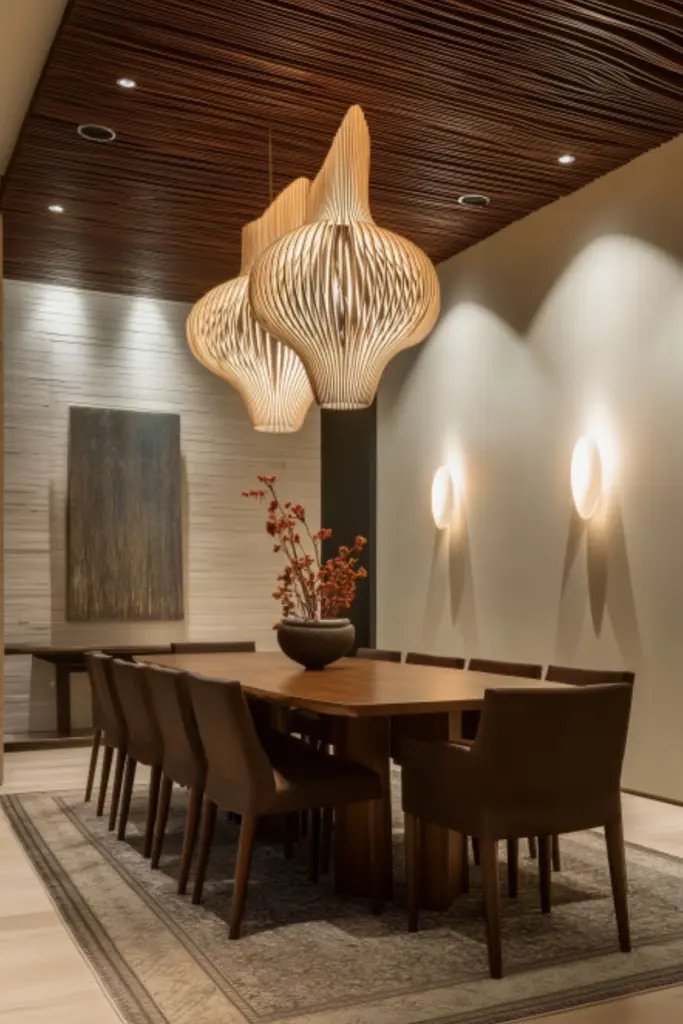
Lighting transforms a minimalist space from stark to sophisticated. A statement pendant—perhaps a sculptural LED fixture, clear glass orb, or slim linear form—anchors the dining table and sets a visual focal point.
Ambient lighting is key. Recessed ceiling lights or concealed LED strips create a gentle wash of illumination without visible fixtures. If your dining area shares space with the kitchen, add dimmable task lighting under cabinets or shelves.
Wall sconces at sideboard level add warmth and highlight décor with subtle glow. Post-dinner rewind can happen under softer light—use candles or flameless LED luminaries for ambiance.
Invest in dimmer switches. They allow the space to move from bright morning meetings to romantic dinner scenes. Consider bulbs with a color temperature around 2700–3000K for warm but crisp lighting.
| Lighting Type | Positioning | Purpose |
|---|---|---|
| Statement pendant | Centered over table | Defines dining space, creates focus |
| Recessed/strip lighting | Ceiling or under cabinets | Even ambient light without clutter |
| Wall sconces | Above sideboard or feature wall | Adds soft glow and dimension |
| Candles/LED luminaries | Tabletop or console display | Enhances ambience and intimacy |
Layering Texture and Materials to Soften Minimalism
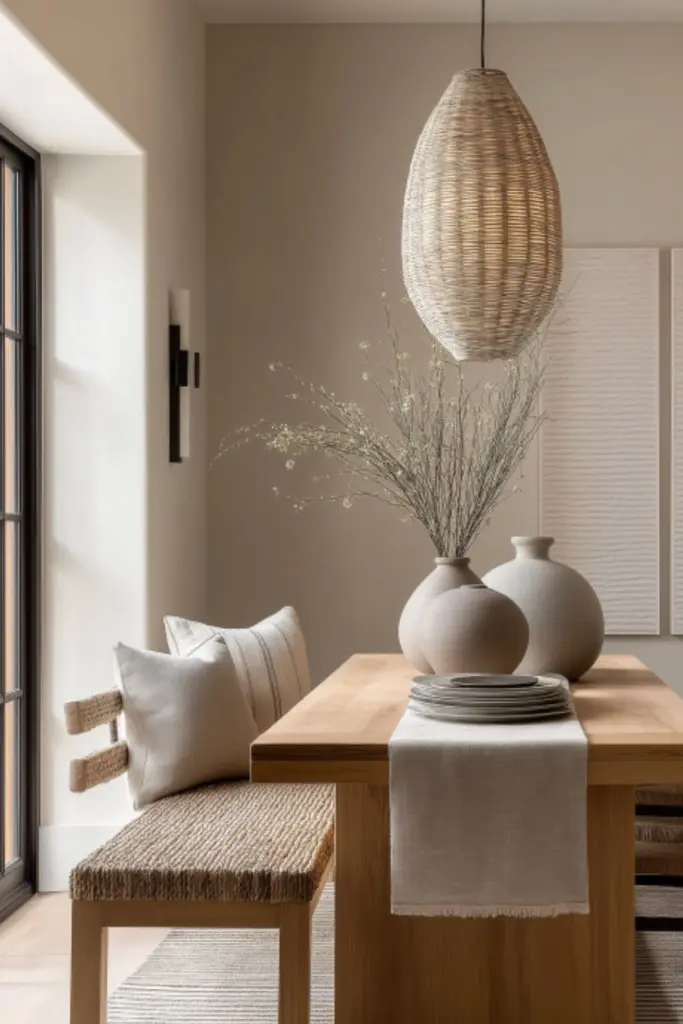
A purely white or monochrome space can feel cold—but strategic texture and material layering bring warmth. Introduce wood in natural tones: a timber table top, walnut chairs, or a rattan accent piece.
Textiles play a key role. A woven runner on the table, natural-fiber rug underfoot, or linen window shades add tactile depth without visual clutter. For cold seasons, a soft throw over a bench invites comfort.
Intersperse stone or ceramic pieces: a matte vase, textured candleholder, or uneven planter brings organic balance and light.
| Material or Texture | Recommended Use | Visual Impact |
|---|---|---|
| Wood accents | Table top, chairs, sideboard | Natural warmth and grain contrast |
| Textiles | Rug, runner, bench throw | Softens hard surfaces, adds tactility |
| Stone/ceramic objects | Centerpiece, sideboard display | Organic depth, understated art |
Curating Decor Accents that Feel Purposeful
In minimalist decor, every accent should earn its place. Choose few, well-chosen pieces that echo your design focus. A single sculptural vase, a stone bowl, or a slimed framed abstract print can become the room’s quiet star.
Scale is important. Avoid small clutter. Instead, opt for a large statement plant, oversized art, or a substantial ceramic vessel. Keep surfaces cleared except for daily essentials—placemats, a candle, or a decorative tray.
Rotate accents seasonally to keep the ambiance fresh—often with no more than 3–5 items per surface.
| Accent Focus | Recommended Scale | Minimalist Benefit |
|---|---|---|
| Sculptural item | Large vase, urn, or pottery | Adds quiet visual interest |
| Oversized artwork | Canvas or framed print above sideboard | Creates focal point without clutter |
| Decorative tray/candle | On table or console | Functional elegance |
| Statement plant | Floor or tabletop | Brings life and soft contrast |
Integrating Hidden Storage to Maintain Clarity
A minimalist dining room relies on functional storage that disappears into the design. Closed storage is key—benches with lift-up lids, sleek sideboards, or integrated shelving behind handleless doors.
Choose minimal hardware—recessed pulls or push-to-open drawer systems help maintain a clean façade. Design built-in shelving niches to hold dishes or glassware, but use door fronts so items aren’t fully exposed.
Think double duty: a bench with storage beneath can hold linens or board games. A sideboard with a sliding panel offers display space and hidden utility. Consider storage elements as sculptural forms, not just practical units.
| Storage Option | Function | Design Integration |
|---|---|---|
| Lift-top bench | Seating + hidden space | Neutral covers keep shape streamlined |
| Handleless sideboards | Plates, linens, barware | Clean fronts, flush alignment |
| Sliding-front cabinet | Mixed display + concealed items | Change exposure by sliding panels |
| Bench or nook shelving | Books or decor | Blend with wall color to drop visually |
By concealing clutter and confining display to strategic niches, your minimalist dining room maintains clarity and calm.
Blending Indoor and Outdoor Ambiance with Subtle Continuity
Modern dining rooms often face patios or balconies. Create a smooth transition by aligning flooring—wood or wood-look tile—and echoing furniture finishes outside.
Use glass doors to connect interiors visually. Outdoor furniture in minimal form—slender metal chairs and neutral cushions—continues the theme. Strategic lighting outside, like recessed deck LEDs or wall-mounted sconces matching interior styles, unites both spaces.
A potted tree or sculptural grass near the threshold weaves the greenery inside with nature outside.
| Cross-Space Feature | Role in Continuity | Design Coordination |
|---|---|---|
| Shared flooring style | Visual flow indoors to outdoors | Choose durable, matching materials |
| Coordinate furniture | Aesthetic connection | Match outdoor seat forms and tone |
| Glass doors | Reflect light and view | Unobstructed by heavy drapery |
| Potted focal plant | Connects nature across threshold | Select large plant in minimalist pot |
Conclusion
Crafting a modern dining room with sleek minimalist style isn’t about removal—it’s about refinement. Thoughtful layout, quality furniture, layered materials, ambient lighting, and hidden storage transform spaces into elegant experiences. With curated decor and indoor-outdoor coherence, your dining area becomes a place of balance, calm, and connection.
Minimalism doesn’t demand starkness—it demands intention. By selecting each design element with purpose, you create a space where every meal shines and every conversation unfolds in serene style. Your dining room can be modern, inviting, and effortlessly graceful—all with fewer details and a clearer vision.

